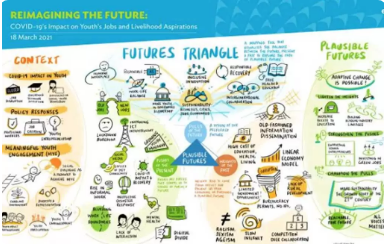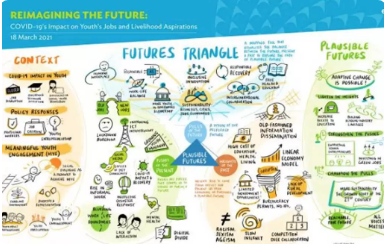Introduction
Asia and the Pacific is home to almost 60% of young people in the world. The opportunities to maximize their potential for innovation and sustainable development is vast. The Asian Development Bank (ADB) Strategy 2030 suggests that demographic dividends are often correlated with strong economic development and social progress, but this is contingent on the ability of countries to offer quality jobs and maximize workers’ productivity. In fact, the youth of the region face significant barriers to social and economic inclusion, especially in terms of education and employment.
COVID-19 risks entrenching these inequalities. Young people are suffering from job losses, reduced working hours, disrupted education and training, and difficulties in transitioning from school to work. A 2020 quantitative assessment conducted by the International Labour Organization (ILO) and the ADB showed that 15- to 24-year-old workers in the region face worse short- and long-term consequences than older workers because of the effects of the pandemic. Evidence from previous socioeconomic shocks also indicates disproportionate negative impacts on youth labor market prospects.
There is a growing body of knowledge that shows meaningfully engaging youth in programs and policies leads to more relevant and effective solutions. ADB’s Youth for Asia (YfA) initiative convened two regional intergenerational consultations in order to learn more about how young people are navigating education and employment during the COVID-19 pandemic and their priorities for response and recovery. This article shares the findings of the consultations and provides recommendations for increasing youth-adult collaboration.
Analysis
Figure 1: Plausible Futures for Youth Pandemic Recovery


Among major funders of youth employment globally, there has recently been a growing commitment to understanding more about why and how the engagement of youth in measures intended to support them improves outcomes. For example, earlier this year, the Youth Employment Funders Group published: “Youth Voices in Youth Employment: A Roadmap for Promoting Meaningful Youth Engagement in Youth Employment Programs”. This guide sets out the case for inclusive and participatory design and implementation processes for and with youth and presents a five-part framework for development partners to improve their youth engagement practices. It provides a useful basis for coordinated action and ongoing research.
Safe spaces for intergenerational dialogue are an important feature in ensuring youth voices are heard in the regional policy discourse on youth employment. Analyzing and sharing the findings from two consultations convened by ADB YfA adds nuance and depth to what we learn through quantitative research. The first consultation was held at Asia Pacific Youth Symposium (APYS) in August 2020. The second one is part of the Southeast Asia Development Symposium (SEADS) last March 2021. This article is released on the second APYS in celebration of International Youth Day 2021. Three priorities are identified to support the economic recovery of young people in the region. Furthermore, participants highlighted different enablers and barriers to consider when leveraging these opportunities.
Ensuring inclusive quality education, training, and jobs
Nearly all APYS (14 out of 16) and SEADS (4 out of 5) groups highlighted the importance of ensuring that labor market opportunities remain inclusive to all youth regardless of gender, socio-economic status, disabilities, among other factors. Jobs and livelihood opportunities must provide decent wages, align with their passions, and be accessible to all. Collaboration between private and public institutions was highlighted to help connect the youth with emerging productive opportunities during and after the pandemic. This will entail breaking down barriers such as high upfront costs in education and training and the lack of role models for the youth.
Leveraging the potential of digital and green transformations to create new job opportunities
Increased digitalization and the transition to green economies can generate new lines of work that benefit young people, who are digital natives. While these sectors offer great potential for youth employment, high-entry costs to access such occupations, in particular skills needs, were cited as a significant barrier alongside a concern for the “digital divide” among vulnerable youth.
Reimagining intergenerational partnership
Participants reflected on the importance of collaboration between young people and adults to drive positive learning and employment outcomes, especially in this pandemic. Consultation and participation processes need to be strengthened to create more opportunities to engage youth in policymaking and programming, for example through governance or leadership roles in jobs and livelihood projects or policy-making forums. Efforts to reduce prejudices or biases from both youth and adults’ sides will be required. Young people must be seen as contributors, not just beneficiaries.
Figure 2: Positive Vision to Positive Action
Recommendations
Increasing young people’s economic empowerment requires the active commitment of stakeholders. The government is central to creating an enabling environment that promotes opportunities and inclusive growth. The private sector—including micro, small, and medium enterprises—is the engine of quality job creation. Investments and support by businesses in youth recruitment, training, and lifelong learning will expand prospects for the youth affected by the COVID-19 crisis. Civil society also plays a critical role particularly in reaching marginalized youth and addressing data gaps.
To increase the meaningful engagement of youth in programs and policies, practical steps that stakeholders can take include the following:
- embrace the heterogeneity of youth by undertaking stakeholder analysis, and make sure youth diversity is reflected in the design of jobs and livelihood initiatives;
- clearly identify the role of youth in contributing to jobs and livelihood initiatives, provide more space for them to contribute, and develop inclusive intergenerational participation plans for project interventions; and
- change perception/behavior toward youth–adult partnerships and encourage more mentorship.
Active involvement of youth throughout a program’s lifecycle strengthens the relevance and sustainability of youth employment interventions. A positive intergenerational relationship will help maximize each generation’s contributions to attain better development outcomes for all.
Resources
Asian Development Bank (ADB). 2018. Strategy 2030: Achieving a Prosperous, Inclusive, Resilient and Sustainable Asia and the Pacific. Manila.
ADB and International Labour Organization (ILO). 2020. Tackling the COVID-19 Youth Employment Crisis in Asia and the Pacific. Bangkok: ILO and Manila: ADB.
H. Osborne, P. Vandenberg, and C. Morris. 2020. Putting Youth Employment at the Center of Asia’s Pandemic Recovery. Development Asia. 20 November.
ILO. 2020. Youth & COVID-19: Impacts on Jobs, Education, Rights and Mental Well-being. Geneva.
ILO. 2021. ILO Monitor: COVID-19 and the World of Work. Seventh Edition: Updated Estimates and Analysis. Geneva.
ILO. 2021. Statistical Brief: An Update on the Youth Labour Market Impact of the COVID-19 Crisis. Geneva.


